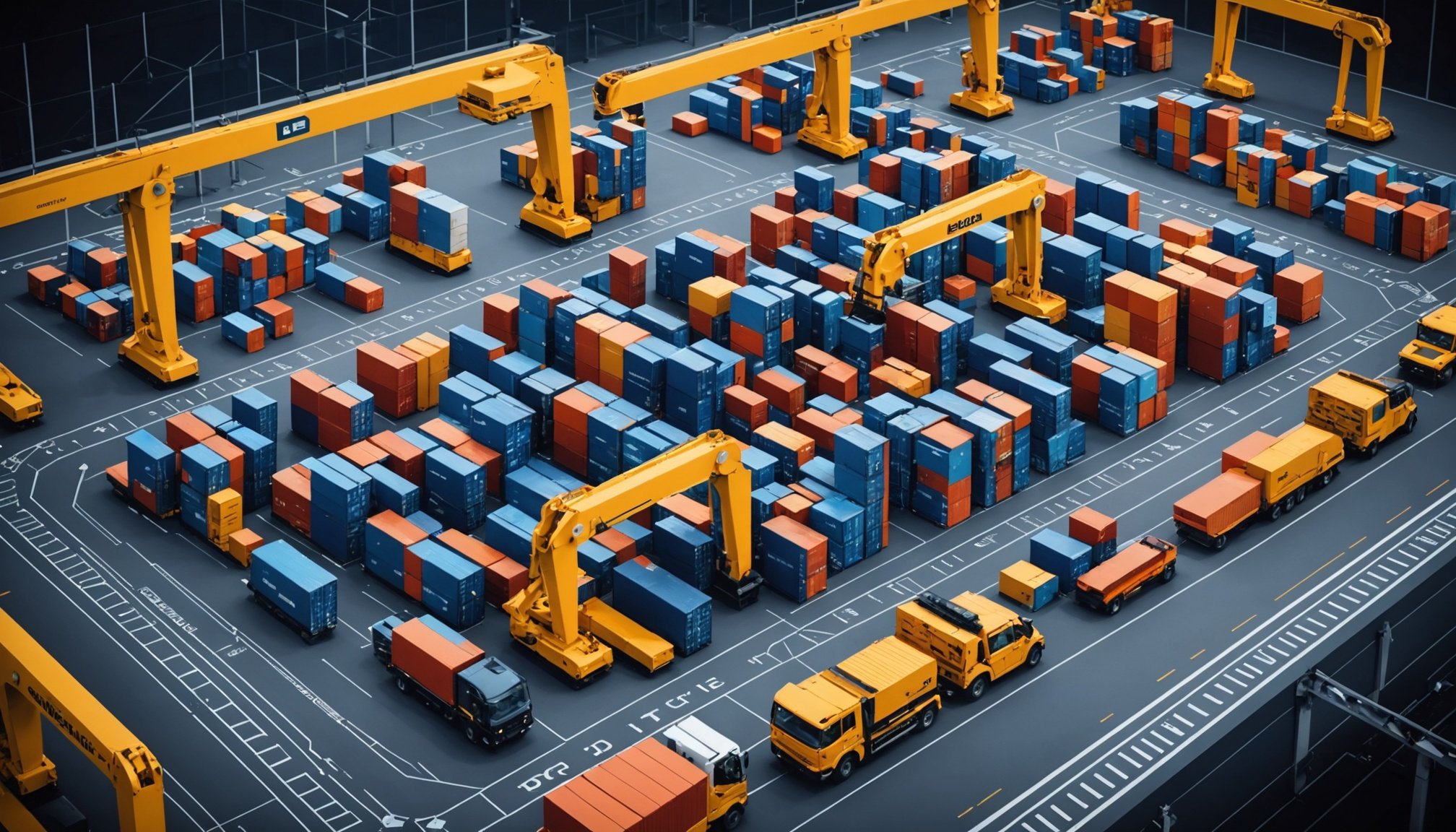Introduction to AI and Blockchain in Supply Chain Security
In today’s rapidly evolving landscape, AI in supply chain management has become a critical component for enhancing efficiency and security. Artificial Intelligence (AI) empowers systems to predict disruptions, optimize route planning, and enhance demand forecasting, which are vital for maintaining seamless operations. By processing vast amounts of data, AI identifies patterns and anomalies, ensuring that the supply chain remains resilient against threats.
Blockchain advantages lie in its ability to offer a transparent and immutable ledger. This is crucial in supply chain security, facilitating the tracking of goods from origin to destination. Each transaction is recorded and verified, building trust among stakeholders and reducing the risk of fraud or counterfeiting.
Have you seen this : Revolutionizing document security: a comprehensive guide to implementing blockchain for effective management
Security in modern supply chain management is paramount. The integration of AI and blockchain technologies provides a formidable defense against cyber threats and data breaches. These innovations support the development of a robust infrastructure that minimizes vulnerabilities and enhances protection.
Synergizing these technologies allows businesses to create a secure environment where data is both accurate and accessible. This ensures compliance with industry standards and boosts consumer confidence in product integrity. Harnessing supply chain security innovations is indeed a strategic move in safeguarding global commercial activities.
Also to discover : Developing a secure ai-driven identity verification system for safe remote access
Benefits of AI in Supply Chain Security
The integration of AI benefits within supply chain security is transformative. Predictive analytics plays a crucial role in assessing risks by analysing large datasets to forecast potential vulnerabilities. This allows businesses to preemptively address issues that could disrupt operations, saving time and resources in the long run.
Threat detection is another key advantage. AI systems continuously monitor supply chains in real-time, spotting anomalies and potential threats before they materialise. This ensures a proactive security posture, drastically reducing response times to security incidents.
Furthermore, AI enhances supply chain security by automating responses. Once a threat is detected, AI systems can automatically initiate protocols to mitigate risks, such as alerting security teams or temporarily altering supply routes. This autonomy not only speeds up response times but also minimises human error, making security measures more reliable.
In essence, the adoption of AI within supply chains provides a robust framework for enhancing security. By harnessing the capabilities of predictive analytics and real-time threat detection, organisations can ensure a more secure and resilient supply chain, better prepared to face modern challenges.
Advantages of Blockchain in Supply Chain Management
Blockchain technology offers significant advantages in supply chain management, particularly in ensuring data integrity and enhancing transparency. By design, a blockchain maintains a tamper-proof ledger where each block of data is linked to the previous one, making alterations nearly impossible. This ensures that the recorded data remains accurate and reliable, which is crucial for maintaining the credibility of supply chain records.
Furthermore, blockchain’s transparent nature enhances traceability. Every transaction can be tracked from its origin to its destination with ease. This feature not only provides stakeholders with real-time visibility into the supply chain process but also enables them to trace the journey of individual products. Such transparency is invaluable for quality control and accountability, as it allows for prompt identification and rectification of issues.
Additionally, blockchain reduces fraud and errors in transaction records by automating formerly paper-based processes. Smart contracts, integral to many blockchain systems, automatically execute and verify transactions. This reduces human error and the possibility of fraudulent activity. As a result, businesses can save time and resources, ultimately boosting efficiency and trust among partners and consumers alike. Blockchain stands as a robust solution that addresses key challenges in modern supply chain management.
Case Studies of Successful Integration
In recent years, several real-world applications have demonstrated the transformative power of integrating AI and blockchain into traditional business practices. In particular, supply chain industries have been at the forefront, leveraging these technologies to streamline operations and enhance transparency.
One notable case study involves a major retailer that implemented blockchain to track products across its supply chain. By utilising a decentralised ledger, the company improved traceability, allowing them to quickly identify and address inefficiencies or issues, thereby enhancing overall customer trust.
Success metrics from this initiative revealed substantial improvements, including a 30% reduction in record discrepancies and a 50% faster resolution of disputes. These metrics underscore improvements in supply chain management and customer satisfaction.
However, the journey wasn’t without its challenges. The company faced initial integration issues, such as data compatibility and the need for employee training. Overcoming these hurdles required diligence and collaboration between IT and operational teams. Importantly, they learned that success hinges on continuous monitoring and adaptation of technology to fit evolving business needs.
These supply chain success stories highlight not just the solutions but also the ongoing commitment needed to harness the full potential of AI and blockchain technologies effectively.
Implementation Strategies for Businesses
When considering implementation strategies for adopting AI and blockchain technologies, it’s essential to have a detailed integration plan. This process often starts with a thorough needs assessment to determine how these technologies can enhance business operations.
Once needs are identified, businesses should develop a clear roadmap for technology adoption. This roadmap serves as a strategic guide, detailing key milestones and timelines. It is vital to understand that successful integration requires careful planning, including training employees and addressing potential resistance.
Collaboration with vendors and technology partners is crucial. By partnering with technology partners who specialize in AI and blockchain, businesses can gain access to innovative solutions and expertise. These collaborations often provide support for troubleshooting, customization, and the scalability of technology solutions.
Moreover, establishing efficient communication channels with vendors can simplify problem-solving and speed up the adoption process. It’s advisable to choose vendors with a proven track record and the flexibility to adapt to the unique needs of your business.
In conclusion, businesses can achieve seamless integration by prioritising strategic planning, maintaining open lines of communication, and leveraging expert partnerships. This approach ensures that new technologies are not only effectively implemented but also provide lasting value.
Potential Challenges and Risks
When implementing robot hoovers, several implementation challenges may arise. The initial setup can be complex, requiring specialized knowledge for seamless integration into existing systems. Users often face difficulties in syncing the device with their smart home ecosystem. Misconfigurations might hinder the effectiveness and usability of the robot hoovers.
Cybersecurity Concerns
Cybersecurity risks are a significant consideration. As these devices connect to home networks, they potentially expose users to unauthorized access and data breaches. It’s crucial to ensure that all software components are updated regularly and that strong, unique passwords are used and maintained.
Cost Implications
Understanding the cost factors is essential for budgeting accurately. The upfront investment includes not only the purchase price but also potential expenses for installation services and premium features. Additionally, ongoing maintenance costs should be considered, such as replacing parts like brushes or filters and buying consumables like specialized cleaning solutions.
However, investing in robot hoovers can lead to long-term savings through reduced manual cleaning efforts and efficient energy consumption. A thorough evaluation of both initial and recurring costs allows for informed decision-making and ensures a smooth transition to this technological enhancement within the home environment.
Industry-Specific Applications
Industry applications are evolving, offering sector-specific solutions that are transforming the landscape of industries such as retail and manufacturing. Tailored solutions leverage innovations like artificial intelligence (AI) and blockchain technologies to meet specific industry needs. These technologies bring comparative advantages by enhancing efficiency, accuracy, and transparency.
In the logistics sector, for instance, logistics innovations created by AI streamline supply chain processes, allowing for precise tracking and real-time data analysis. This results in reduced costs and increased customer satisfaction. Meanwhile, blockchain applications ensure the integrity and security of transactions, simplifying international freight operations by providing tamper-proof records.
In retail, AI-powered solutions personalise customer experiences through data analysis and predictive analytics, leading to increased sales and customer loyalty. Blockchain, on the other hand, ensures secure payment methods and manages supply chain interactions efficiently, providing a seamless shopping experience.
The future trends point towards further integration of AI and blockchain across sectors. Innovations such as AI-powered predictive maintenance in manufacturing and blockchain’s improving capability in managing smart contracts across industries are set to redefine industry applications. By embracing these technologies, businesses can achieve unparalleled optimisation, paving the way for sustainable growth and competitiveness.
Traditional vs. Modern Security Solutions
When evaluating traditional security measures compared to modern solutions in supply chain management, several distinctions appear. Historically, security involved manual checks, inventory logs, and basic surveillance to monitor assets. These methods, while foundational, often required substantial manpower and could be prone to human error.
Modern solutions, on the other hand, leverage technology to enhance efficiency and accuracy. Automated systems, like RFID tagging and IoT devices, allow real-time tracking and monitoring of goods. This not only minimises manual oversight but also significantly reduces the risk of theft and error.
Adopting such new technologies offers myriad advantages. Automation and artificial intelligence provide predictive analytics for potential threats, enabling pre-emptive action. For instance, machine learning algorithms can quickly identify anomalies in shipping patterns, highlighting possible concerns before they escalate.
Looking to the future, modern solutions like blockchain stand ready to transform security protocols further. With its decentralised nature, blockchain promises more transparent and tamper-proof ledgers, enhancing trust across the supply chain. While traditional security methods laid important groundwork, the move towards smarter, tech-driven approaches appears inevitable for a robust and secure supply chain.
Having both approaches coexist could bridge existing gaps, leveraging the strengths of each to foster a seamless and secure environment.











